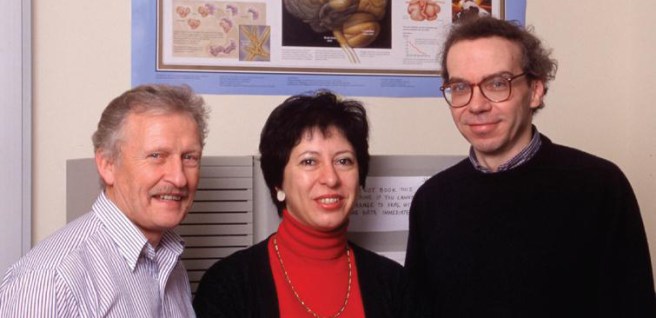
|
On the 27th June, 1997, a research report was published in the prestigious scientific journal ‘Science’ that would change the world of Parkinson’s disease research forever. And I am not exaggerating here. The discovery that genetic variations in a gene called alpha synuclein could increase the risk of developing Parkinson’s disease opened up whole new areas of research and eventually led to ongoing clinical trials of potential therapeutic applications. Todays post recounts the events surrounding the discovery, what has happened since, and we will discuss where things are heading in the future. |

Source: listchallenge
It is fair to say that 1997 was an eventful year.
In world events, President Bill Clinton was entering his second term, Madeleine Albright became the first female Secretary of State for the USA, Tony Blair became the prime minister of the UK, and Great Britain handed back Hong Kong to China.

#42 – Bill Clinton. Source: Wikipedia
In the world of entertainment, author J. K. Rowling’s debut novel “Harry Potter and the Philosopher’s Stone” was published by Bloomsbury, and Teletubbies, South Park, Ally McBeal, and Cold Feet (it’s a British thing) all appeared on TV for the first time, amusing and entertaining the various age groups associated with them.

South Park. Source: Hollywoodreporter
Musically, rock band Blur released their popular hit song ‘Song 2‘ (released 7th April), “Bitter Sweet Symphony” by the Verve entered the UK charts at number 2 in June, and rapper Notorious B.I.G. was killed in a drive by shooting. Oh, and let’s not forget that “Tubthumping” (also known as “I Get Knocked Down”) by Chumbawamba was driving everybody nuts for its ubiquitous presence.
And at the cinemas, no one seemed to care about anything except a silly movie called Titanic.

Titanic. Source: Hotspot
Feeling old yet?
In the sports arena, boxer Mike tyson decided to try chewing on Evander Holyfield’s ear, Tiger Woods (aged 21 years old) became the youngest golfer to win the Masters, Manchester United won their 4th Premier League title, and the Green Bay packers won the super bowl.

Tiger, an Oakland Raiders fan. Source: Golfchannel
And finally in 1997, Kylie Jenner of the Kardashians was born, while Deng Xiaoping, Mother Teresa and Princess Diana passed away.
Like I said, an eventful year.
In the world of science, three important events occurred:
- Dolly, the first successfully cloned mammal is revealed to the world by the Roslin Institute (she was actually born in 1996, but kept a secret till 1997).

Dolly. Source: Scotlandnow
2. Mars Pathfinder landed on the surface of Mars.

The most expensive selfie ever? Source: NASA
3. Comet Hale-Bopp graced us with her presence in the northwestern skies from late March through to the end of May.

Comet Hale-Bopp. Source: Pinterest
Now, in addition to all of these major events, a long sequence of interesting research findings were coming to to fruition in the form of the publication in journal Science that we mentioned above. The sequence began in the late 1980s, when a neurologist followed a hunch to the village near the city of Salerno in southern Italy.

Salerno. Source: Worldatlas
The neurologist in question was Dr Lawrence Golbe (now at Rutgers Robert Wood Johnson Medical School – he also maintains a really good blog on the neurodegenerative condition progressive supranuclear palsy or PSP).

Prof Lawrence Golbe. Source: PSP-Blog
In 1984-85, Dr Golbe had encountered not one, but two people of American Italian background with an early-onset form of Parkinson’s disease. Further investigations suggested that other members of their respective families were also affected by the disease. But the REALLY crazy detail was that both of these Parkinson’s affected families originally came from the region surrounding Salerno.

Salerno, Italy. Nice spot for doing some research. Source: Cruiseweb
This curious fact struck Dr Golbe as more than simply an intriguing co-incidence and he decided to follow it up. While visiting Salerno in the late 1980s, Dr Golbe carefully reconstructed a family tree of his two Parkinson’s affected families, and discovered that his original two affected patients were actually seventh cousins – two of 574 descendants from a couple who married sometime around 1700. But the truly remarkable part of this analysis was that 61 of the recent descendants had developed Parkinson’s disease. Dr Golbe collected blood samples from many of the descendants and returned to the US to analyse their DNA.
Unfortunately this effort proved a very long and difficult task, simply because DNA analysis at the time was extremely difficult. The researchers literally had to wait not only for better DNA analysing technology to be available. These problem were eventually resolved by the formation of a collaboration with researchers at the National Institutes of Health, Dr Mihael Polymeropoulos and Prof Robert L. Nussbaum.

Dr Mihael Polymeropoulos. Source: BizJournal

Prof Robert L. Nussbaum. Source: Gettyimages
The researchers were eventually able to determine that most of the DNA samples from the people affected by Parkinson’s disease had mutations on an area of what we call the long arm of chromosome 4. This discovery was presented in this research report:

Title: Mapping of a gene for Parkinson’s disease to chromosome 4q21-q23.
Authors: Polymeropoulos MH, Higgins JJ, Golbe LI, Johnson WG, Ide SE, Di Iorio G, Sanges G, Stenroos ES, Pho LT, Schaffer AA, Lazzarini AM, Nussbaum RL, Duvoisin RC.
Journal: Science. 1996 Nov 15;274(5290):1197-9.
PMID: 8895469
Interestingly, the researchers had DNA from three independent Greek families that also exhibited the same early onset form of Parkinson’s disease. The affected members of those families also had genetic mutations in the long arm of chromosome 4, and the results of analysing their DNA were also included in the report.
Soon after publication, regions of chromosome 4 were mapped out, including the area covering the Parkinson’s disease associated genetic mutations. The researchers quickly worked out that the variants lay in a gene called SNCA, which encoded a protein called alpha synuclein.

The 23 pairs of chromosomes and variants (green) in chromosome 4. Source: JAMA
Specifically, the researchers found that the most common genetic mutation in their Parkinson’s affected family was a G209A substitution in the SNCA gene.
What does this mean?
DNA is made up of nucleotides: Guanine, Adenine, Thymine, Cytosine (or the GATCs).

GATC nucleotides in DNA. Source: Pinterest
In normal DNA, the nucleotides pair up to form base pairs: Guanine binds with Cytosine, while Adenine connects to Thymine. But in one particular location of the SNCA gene (nucleotide 209) in these Parkinson’s affected individuals, Guanine has been replaced by Adenine.
Amazing isn’t it.
The human genome contains approximately 3 billion of these base pairs. And yet if just one of them goes wrong in location 209 of the SNCA gene, the affected individual can develop an early form of Parkinson’s disease.
The researchers further established that the pattern of inheritance of this genetic variant was autosomal-dominant (meaning if you inherit the abnormal gene from only one parent, you can get the disease), and the form of Parkinson’s disease associated with this mutation is early-onset (usually in the 40s).
On the 27th May, 1997, Nussbaum submitted a manuscript detailing the study and the findings to the journal Science for peer-review and publication consideration. One month later (a remarkably quick turnaround time) the research report was published:

Title: Mutation in the alpha-synuclein gene identified in families with Parkinson’s disease.
Authors: Polymeropoulos MH, Lavedan C, Leroy E, Ide SE, Dehejia A, Dutra A, Pike B, Root H, Rubenstein J, Boyer R, Stenroos ES, Chandrasekharappa S, Athanassiadou A, Papapetropoulos T, Johnson WG, Lazzarini AM, Duvoisin RC, Di Iorio G, Golbe LI, Nussbaum RL.
Journal: Science. 1997 Jun 27;276(5321):2045-7.
PMID: 9197268
Now, if you take nothing else away from this reading, understand this: Before 27th June 1997, it was generally agreed that there was a trend for Parkinson’s disease to be shared in certain family trees, where several individuals across different generations were diagnosed with Parkinson’s disease.
After 27th June 1997, we had proof.
We also had a new focus for Parkinson’s disease research. And other researchers were quick to start exploring this new target.
In fact, just two months later (and three days before Princess Diana died in a a car crash in a road tunnel in Paris), the results of another study were published that would further cemented alpha synucleins place in the world of Parkinson’s disease:

Title: Alpha-synuclein in Lewy bodies.
Authors: Spillantini MG, Schmidt ML, Lee VM, Trojanowski JQ, Jakes R, Goedert M.
Journal: Nature. 1997 Aug 28;388(6645):839-40.
PMID: 9278044
In this study, the investigators showed that alpha synuclein was present in Lewy bodies – the characteristic features of the Parkinsonian brain:

Alpha synuclein in Lewy bodies. Source: Nature
The investigators, led by Prof Maria Grazia Spillantini and Prof Michel Goedert (below), had analysed sections of brain from six people with Parkinson’s disease and four with dementia with Lewy bodies.

Mr Ross Jakes, Prof Maria Grazia Spillantini and Prof Michel Goedert. Source: IOSpress
Their initial study was quickly followed up by further supporting research a few months later in 1998:

Title: alpha-Synuclein in filamentous inclusions of Lewy bodies from Parkinson’s disease and dementia with lewy bodies.
Authors: Spillantini MG, Crowther RA, Jakes R, Hasegawa M, Goedert M.
Journal: Proc Natl Acad Sci U S A. 1998 May 26;95(11):6469-73.
PMID: 9600990 (This article is OPEN ACCESS if you would like to read it)
This research report provided a more thorough characterisation of the alpha synuclein deposits in the brain, and the results were replicated by other research groups (Click here to see those reports). Several years later, in 2001, a research report was published regarding analysis of postmortem brain samples from a person who had the SNCA mutation we discussed above. Abundant alpha synuclein positive Lewy bodies were present in that brain (Click here to read more about that study).
Collectively, these discoveries gave us a genetic limit to Parkinson’s disease as well as a marker of the characteristic feature of Parkinson’s in the brain – and to this day, the presence of alpha synuclein labelled Lewy bodies in the brain is required for a definitive diagnosis of Parkinson’s disease.
For a very good review on the history of these discoveries, please click here.
Have we increased our understanding of the genetics of Parkinson’s disease since then?
Yes! In fact, after the discovery of an association between alpha synuclein and Parkinson’s disease, the progress was very swift. Just one year later, it was discovered that another early onset form of Parkinson’s disease was associated with mutations in a gene called Parkin:

Title: Mutations in the parkin gene cause autosomal recessive juvenile parkinsonism.
Authors: Kitada T, Asakawa S, Hattori N, Matsumine H, Yamamura Y, Minoshima S, Yokochi M, Mizuno Y, Shimizu N.
Journal: Nature. 1998 Apr 9;392(6676):605-8.
PMID: 9560156
And in 2003, Nick Wood and colleagues found that mutations in another gene, DJ1 were also associated with young-onset Parkinson’s disease (Click here to read more about that article).
What does it all mean?
While most folks in the Parkinson’s community are recognising 2017 as the 200 year anniversary of the first description of Parkinson’s disease by Mr James Parkinson (31st May, 1817 – click here to read more about this), it is also the 20th anniversary of another important event in Parkinson’s disease history. The discovery that genetic mutations in a gene called alpha synuclein were associated with Parkinson’s disease has revolutionised the research of this condition.
On the 12th April this year, I noted that over 6200 scientific articles had been published since the discovery of association between Parkinson’s disease and alpha synuclein – that’s over 300 publications per year (Click here to read that post). In the last two months, a further 150+ research articles have been published on the topic of Parkinson’s disease and alpha synuclein, taking the total today to 6354 (don’t believe me? Click here). The amount we know about alpha synuclein and Parkinson’s disease is literally growing exponentially.
In addition to learning a great deal about the basic biology of alpha synuclein and its connection to Parkinson’s disease, all of this research has led to 26 clinical trials involving alpha synuclein – both therapy-based (in the form of vaccine and immunotherapy studies – click here for more on this) as well as testing diagnostic tests. And more trials are planned!
The discovery of an association between Parkinson’s disease and alpha synuclein fundamentally changed the course of research in this field, and so I thought it was appropriate to observe this anniversary.
The banner for todays post was sourced from kofc10561
All this info just for tea and cake and thank yous. Thanks
LikeLike
And usually there isn’t even cake! 😊
LikeLike
Hi Simon,
You have reported that both Doxycycline and Baicalein interact with a-syn and form non-toxic combinations and both drugs are cheap, safe and available.
Some people wait for the sign to change from “Don’t Walk” to “Walk” and some don’t;
but research you report of great value and much appreciated.
LikeLike